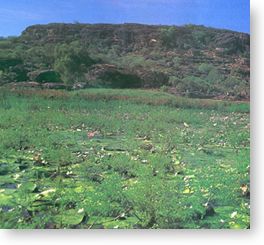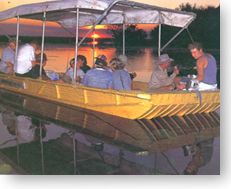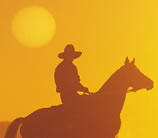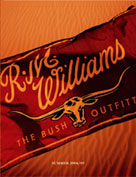ADVENTURE
Ultimate Arnhem Land
Mount Borradaile - where wilderness, wildlife and eco-tourism meet
Story: Kerry Sharp
Photographs: Frank Woerle
 A
tantalising aroma wafts from the mesh lined kitchen of Max and Philippa Davidson's
Mount Borradaile safari camp on the edge of the secluded Arnhem Land floodplain,
350 km east of Darwin.
A
tantalising aroma wafts from the mesh lined kitchen of Max and Philippa Davidson's
Mount Borradaile safari camp on the edge of the secluded Arnhem Land floodplain,
350 km east of Darwin.
The guests have just returned from a sunset cruise among the water lillies, crocs and teeming birdlife on a nearby billabong, an exhilarating interlude followed by a bone-rattling drive home across a boggy creek and sandy track in one of Max's popular fleet of open 4WDs.
People come from all corners of the globe to experience this special place in the Top End, and the energy they spend in taking in the astounding cultural and wilderness attractions ensures appetites are typically hearty, spirits high and conversations lively at the end of the day.
Above the clatter of plates and cutlery, head chef Ray Curry serves up dumpling stew and bread-and-butter pudding, and graciously accepts compliments about his culinary prowess. He's never had a formal cooking lesson in his life, but he reckons the good old-fashioned food like his mum used to cook always hits the spot after a day in the bush .
 Mount
Borradaile is internationally renowned as one of the richest and most powerful
Aboriginal cultural sites in Australia, a complex gallery of thousands of
rock paintings recording more than 50,000 years of human occupation, and
interspersed with burial sites that can be seen, but not photographed out
of respect for the traditional custodians' wishes.
Mount
Borradaile is internationally renowned as one of the richest and most powerful
Aboriginal cultural sites in Australia, a complex gallery of thousands of
rock paintings recording more than 50,000 years of human occupation, and
interspersed with burial sites that can be seen, but not photographed out
of respect for the traditional custodians' wishes.
The area is also a haven for wetland wildlife - very large crocodiles,
waterbirds which congregate in huge flocks on the local billabongs, abundant
barramundi and the elusive Leichhardt's grasshopper, a vibrant orange and
cobalt blue species found only on the Pityrodia shrubs that grow around Kakadu,
Arnhem Land and Keep River. ![]()
Full story Issue 8, December 1999-January 200


